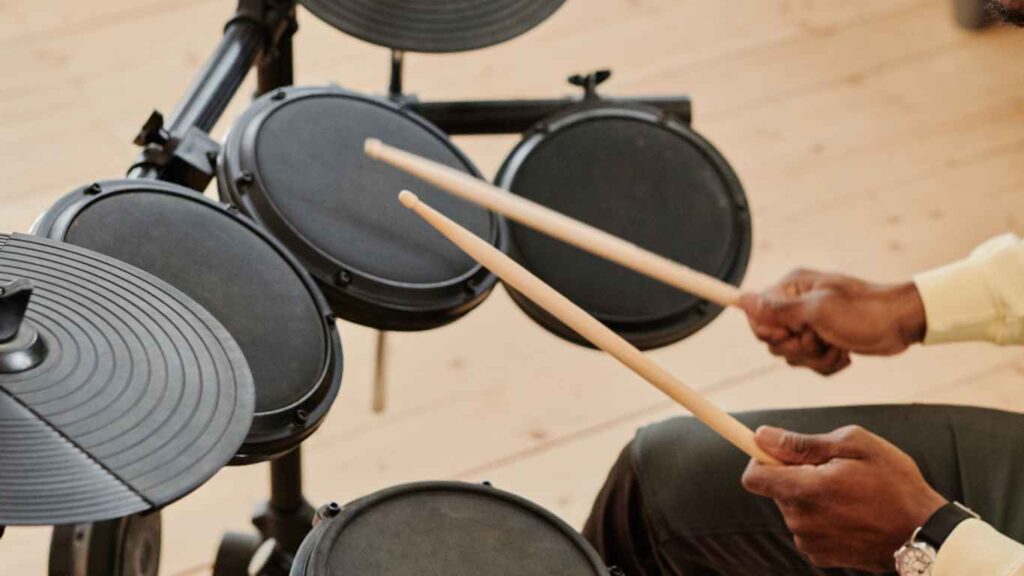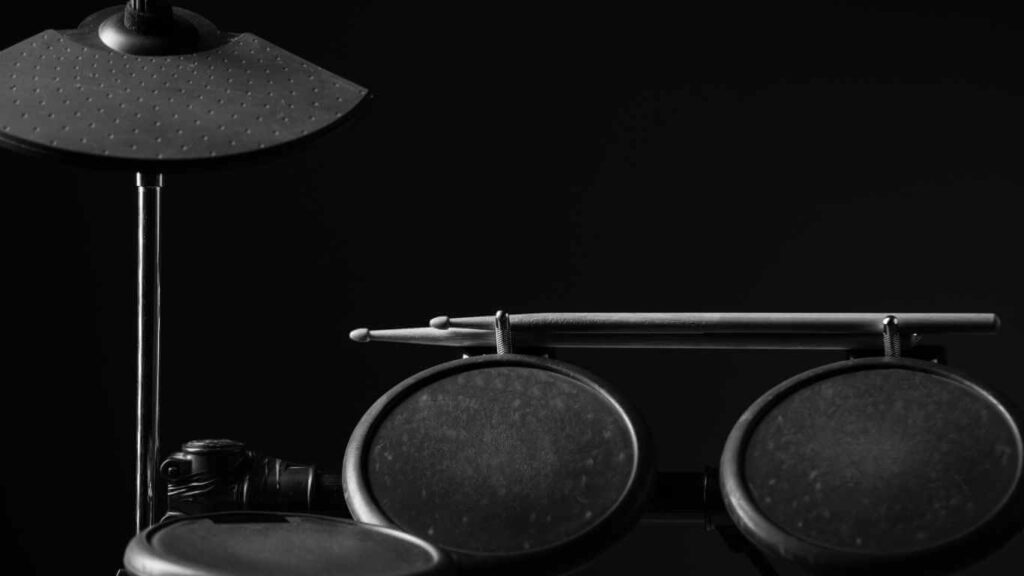Hey there, rhythm aficionados! It’s Ron, your go-to guru for all things drums and percussion. Today, I’m diving into a topic that’s close to the heart of every modern drummer – the pivotal role of rubber heads in electronic drumming. Whether you’re a seasoned pro or a newbie setting up your first kit, understanding the nuances of rubber heads can significantly impact your playing experience. So, let’s roll up our sleeves and explore why these components are more than just parts of an electronic drum set.
The Essence of Rubber Heads
Rubber heads have become a staple in the world of electronic drumming, offering a blend of durability, realistic feel, and affordability that makes them an attractive option for both beginners and seasoned drummers alike. Unlike their mesh counterparts, rubber heads provide a solid, consistent striking surface that closely mimics the rebound of traditional acoustic drum skins, making them an excellent choice for those looking to transition from acoustic to electronic sets without losing the essence of drumming dynamics.
One of the key advantages of rubber heads is their ability to withstand extensive use. Designed for longevity, these heads can endure countless hours of practice and performance, making them a cost-effective solution for drummers who put in a lot of stick time. The robust nature of rubber also means it can resist wear and tear from sticks, brushes, and mallets, maintaining its responsiveness and tactile feedback over time. This resilience is especially beneficial for educational settings, where instruments frequently undergo heavy use by multiple players.

Furthermore, the construction of rubber heads allows for a variety of playing techniques, from light cymbal swells to heavy, driving bass beats. This versatility is crucial for drummers who play across multiple genres and need their electronic kit to adapt to different musical contexts. Additionally, rubber heads tend to produce less acoustic noise than mesh heads or acoustic drums, which is a significant advantage for practice sessions in noise-sensitive environments, such as apartments or late-night home studios.
Despite some criticisms regarding their feel compared to acoustic drumheads, modern advancements in rubber head technology have led to significant improvements in their playability and dynamic range. Manufacturers have developed rubber compounds that offer a more realistic stick rebound and sensitivity to dynamics, allowing for nuanced performances that closely mirror those on an acoustic kit. This evolution in design has not only enhanced the playing experience but also expanded the expressive capabilities of electronic drum sets equipped with rubber heads, solidifying their position in the electronic percussion market.
Diving Deeper: The Technology Behind Rubber Heads
The technology behind rubber heads for electronic drums is a fascinating blend of material science and acoustic engineering, aimed at replicating the feel and responsiveness of traditional acoustic drums. At the core of this technology is the development of specialized rubber compounds that balance durability with a realistic playing experience. These compounds are designed to mimic the rebound and feel of hitting an acoustic drumhead, providing a familiar response for drummers transitioning between acoustic and electronic kits.
Rubber heads are constructed using a process that ensures they have a consistent density and thickness, which are critical factors in achieving a uniform feel across the drum kit. This uniformity is essential for drummers to maintain their technique and dynamics when playing different drums and cymbals on their electronic set. The surface texture of rubber heads is also carefully engineered to provide the right amount of grip and stick noise, contributing to the overall realism of the drumming experience.
Advanced rubber heads incorporate multiple zones of sensitivity, allowing them to produce different sounds depending on where they are struck. This multi-zone capability extends the expressive range of electronic drums, enabling drummers to execute techniques like rim shots or cymbal chokes with accuracy. Furthermore, the integration of piezoelectric sensors beneath the rubber surface translates the force of each strike into an electronic signal with remarkable precision, ensuring that the nuanced dynamics of a drummer’s playing are accurately captured and reproduced.
Manufacturers continuously refine the formulation of rubber used in these heads to enhance their feel and performance. Innovations such as adding air pockets or varying the rubber’s density have led to improvements in how well rubber heads absorb stick impact, reducing hand and wrist fatigue during extended playing sessions. These technological advancements not only improve the playability of electronic drums but also contribute to the longevity of rubber heads, making them a reliable choice for both practice and performance settings.
the technology behind rubber heads for electronic drums represents a sophisticated attempt to blend the tactile feedback and dynamic response of acoustic drumming with the versatility and convenience of electronic percussion. As materials and manufacturing techniques continue to evolve, drummers can expect even greater improvements in the quality and realism of rubber drum heads, further closing the gap between electronic and acoustic drumming experiences.

Choosing the Right Heads: Comparing Brands and Models
Choosing the right rubber heads for your electronic drum set is a crucial decision that can significantly affect your playing experience and sound quality. With several brands and models on the market, each offering its unique features and benefits, navigating the options can feel overwhelming. Here’s a closer look at how to compare brands and models to find the perfect rubber heads for your electronic drums.
Brand Reputation and Quality Start by researching the reputation of brands that manufacture rubber heads for electronic drums. Companies like Roland, Yamaha, and Alesis are industry leaders known for their high-quality products and innovation in electronic percussion. Brand reputation can be a reliable indicator of product quality and customer satisfaction. Read reviews from other drummers and check out online forums and videos to gather insights about the durability, playability, and sound quality of different brands.
Model Specifications and Features Once you’ve narrowed down your choices to a few reputable brands, compare the specific models they offer. Look at the specifications of each model, including the thickness of the rubber, sensitivity, trigger zones, and compatibility with different electronic drum modules. Some models may offer advanced features such as dual or triple triggering for a more dynamic playing experience, allowing you to trigger different sounds from the center and edge of the drum pad or even from the rim.
Playing Feel and Response The playing feel and response of rubber heads can vary significantly between models. Some drummers prefer a firmer feel that closely mimics the rebound of an acoustic drumhead, while others may opt for a softer head that reduces stick noise and is gentler on the wrists and hands during long practice sessions. If possible, try out different models in a music store to get a firsthand experience of their feel and response. This can help you make an informed decision based on your personal playing style and preferences.
Sound Quality and Versatility Consider the sound quality and versatility of the rubber heads. While the electronic drum module primarily determines the sound of your drums, the design and material of the rubber heads can influence the dynamics and expressiveness of your playing. Some heads are designed to offer a broader dynamic range, capturing subtle nuances in your playing from soft ghost notes to powerful accents. Additionally, consider whether the heads support the playing techniques you use most frequently, such as rim shots or brush strokes, to ensure you can express yourself fully.
Price and Value Finally, compare the price of different rubber heads, keeping in mind that the most expensive option is not always the best. Assess the value offered by each model, considering its durability, features, and how well it meets your specific needs. Investing in high-quality rubber heads can enhance your playing experience and may save you money in the long run by reducing the need for frequent replacements.
In conclusion, choosing the right rubber heads for your electronic drum set involves careful consideration of brand reputation, model specifications, playing feel, sound quality, and price. By taking the time to research and compare your options, you can find rubber heads that enhance your drumming experience, meet your performance needs, and provide lasting value.

Integrating Rubber Heads: Practice and Performance
Integrating rubber heads into your electronic drumming setup can significantly impact both practice sessions and live performances. Here’s how to make the most of these versatile components in various playing contexts.
Optimizing Practice Sessions For practice, rubber heads offer a distinct advantage due to their reduced volume, allowing drummers to rehearse for extended periods without disturbing neighbors or family members. The slightly different feel and rebound compared to traditional mylar or mesh heads can also serve as a valuable training tool, encouraging drummers to focus more on technique and precision. To maximize practice efficiency, consider setting up your kit to mimic the layout and feel of an acoustic set as closely as possible. This can involve adjusting the positioning of pads and cymbals and fine-tuning the sensitivity settings on your drum module to ensure that the rubber heads respond realistically to your playing dynamics.
Incorporating rubber heads into practice routines also allows drummers to experiment with a wide range of sounds and styles, thanks to the versatility of electronic drum modules. This can be particularly beneficial for drummers who play in multiple genres or who are looking to expand their musical vocabulary. Additionally, many electronic drum sets with rubber heads come equipped with built-in metronomes and play-along tracks, making it easier for drummers to work on their timing, rhythm, and musicality in a more structured and engaging way.
Enhancing Live Performances When it comes to live performances, rubber heads can offer both practical and sonic advantages. On the practical side, electronic drums with rubber heads are typically more compact and portable than their acoustic counterparts, making them ideal for gigging musicians who need to conserve space and set up quickly. The ability to connect electronic drums directly to a PA system or an amplifier also eliminates the need for extensive microphone setups, further simplifying the performance setup.
Sonically, rubber heads paired with high-quality drum modules can produce a wide array of sounds, from classic acoustic kits to electronic and world percussion. This allows drummers to tailor their sound to the venue and the musical context, whether they’re playing in a small club, a large concert hall, or an outdoor festival. The consistency of volume and tone provided by electronic drums can also be a significant advantage in live settings, ensuring that the drum mix is both powerful and balanced.
For drummers who incorporate electronics into their acoustic setups, rubber heads can serve as a bridge between the two worlds, offering a cohesive playing experience that combines the best of both. By assigning specific sounds or effects to rubber-headed pads, drummers can seamlessly integrate electronic elements into their performances, adding depth and dimension to the music without sacrificing the feel and dynamic range of acoustic drumming.
Tips for Integration To successfully integrate rubber heads into both practice and performance, it’s essential to spend time customizing your setup and familiarizing yourself with the nuances of electronic drumming. Experiment with different sounds and settings to find what works best for you, and don’t hesitate to adjust your playing technique as needed to get the most out of your electronic kit. Regularly updating your drum module’s software and exploring new sound libraries can also help keep your sound fresh and inspiring.
whether you’re honing your skills in the practice room or captivating audiences on stage, rubber heads can significantly enhance your drumming experience. By embracing the unique opportunities they offer for customization, sound exploration, and technical development, you can push the boundaries of your creativity and performance.
Looking Ahead: The Future of Rubber Heads in Drumming
The future of rubber heads in drumming looks promising, with technological advancements and changing musical trends shaping their development and application. As drummers continue to seek versatile, durable, and responsive equipment, manufacturers are motivated to innovate, ensuring that rubber heads remain a vital component of the electronic drumming landscape. Here’s a glimpse into what the future might hold for rubber heads and how they might continue to evolve and influence drumming practices.
Technological Advancements In the coming years, we can expect to see significant advancements in the materials and technology used to produce rubber heads, leading to even greater dynamic response and a more authentic feel. Research and development efforts are likely to focus on creating surfaces that mimic the tactile feedback of acoustic drum skins more closely, reducing the gap between electronic and acoustic drumming experiences. This could involve novel rubber compounds or hybrid materials that offer improved rebound and sensitivity, enabling drummers to express themselves more freely and with greater nuance.
Additionally, the integration of smart technology into rubber heads could open up new possibilities for drummers. Imagine heads that can track your playing dynamics and style, offering real-time feedback or automatically adjusting their response to suit your preferences. Such innovations could make electronic drums more intuitive and personalized, catering to the individual needs of drummers across all skill levels.
Expanding Musical Applications As electronic music continues to evolve and permeate various genres, rubber heads will play an increasingly important role in enabling drummers to adapt and thrive in diverse musical contexts. We can expect manufacturers to offer a wider array of pad sizes and shapes, allowing for more customized and ergonomic setups that reflect the unique requirements of different musical styles. This customization will enable drummers to seamlessly switch between genres, from electronic dance music to jazz fusion, without missing a beat.
Moreover, the use of rubber heads in hybrid drumming setups is likely to become more prevalent. As drummers seek to combine the acoustic warmth and presence of traditional drums with the versatility and control of electronic percussion, rubber heads will serve as a crucial bridge, facilitating a cohesive sound that blends the best of both worlds. This hybrid approach could redefine live performances, offering audiences a richer and more immersive sonic experience.
Sustainability and Innovation Sustainability concerns will also influence the future of rubber heads, with drummers and manufacturers alike looking for eco-friendly alternatives to traditional materials. We may see the development of biodegradable or recycled rubber options that don’t compromise on quality or performance. Such innovations would not only appeal to environmentally conscious musicians but also contribute to a more sustainable music industry overall.
the future of rubber heads in drumming is bright, with endless possibilities for innovation and expansion. As technology advances and musical boundaries continue to blur, rubber heads will undoubtedly remain at the forefront of electronic drumming, offering drummers new ways to explore, create, and perform. Whether through improved materials, smart technology integration, or sustainable practices, the evolution of rubber heads promises to enhance the drumming experience, making it more dynamic, expressive, and accessible to all.
Conclusion: The Unbeatable Value of Rubber Heads
In conclusion, rubber heads hold an indispensable place in the world of electronic drumming. Their blend of durability, cost-effectiveness, and performance makes them a favorite among drummers across genres and skill levels. As technology advances, we can only expect rubber heads to become even more sophisticated, continuing to serve as a cornerstone of electronic percussion. Whether you’re practicing in your apartment or performing on stage, the trusty rubber head is your ally in delivering those beats that get everyone moving.
So, there you have it, folks – a deep dive into the world of rubber heads and their impact on electronic drumming. Whether you’re about to buy your first electronic kit or looking to upgrade your current setup, consider the humble rubber head as a key factor in your decision-making process. It’s not just about hitting the notes; it’s about how you feel when you’re laying down the beat. Keep on drumming, and let the rhythm take you where you need to go.
Read more on rubber pads and compare to mesh heads




